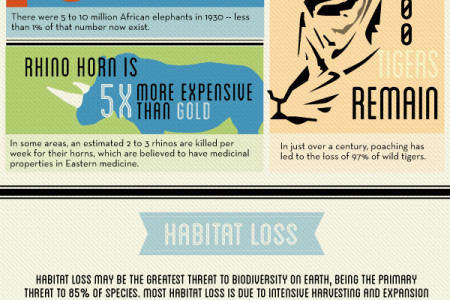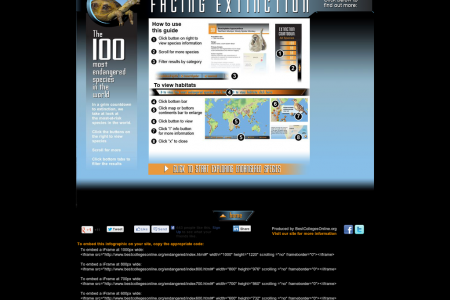
The Last of Their Kind
PHILIPPINE EAGLE Philippine islands of Luzon, Samar, Leyte and Mindanao IBERIAN LYNX Southwestern Spain STATUS: Fewer than 500 left in the wild STATUS: About 85 to 145 adults One of the largest eagles in the world and globally considered as critically endangered since 1969, it was adopted and regularly funded by Filipino boxing star Manny Pacquiao. - Continuing decline partly due to severe depletion of its primary prey, the European rabbit, by disease and over-hunting. 1 Destruction, deterioration and alteration of their habitats have fragmented the lynx populations. Examples include the planting of Mediterranean scrublands and the opening up of roads and forest tracks in previously remote areas. Each pair needs 65 to 130 sq km to raise a single chick successfully, making the species highly vulnerable to the rampant deforestation of recent decades. Breeding eagles favour tall trees with open crowns. Nests are built at heights ranging from 24m to 48m and often used for consecutive nestings. GREY-SHANKED DOUC LANGUR Central Vietnam BAIJI DOLPHIN Yangtze River, China THE LAST OF THEIR KIND STATUS: Last documented sighting in 2002 I In late 2006, a comprehensive visual and acoustic survey failed to find a single dolphin in the Yangtze River - evidence that suggests this species might already be extinct. STATUS: Number estimated at 550 to 700 These animals live in the Central Highlands of Vietnam where almost 10,000 ha of forest are lost annually due to logging and agricultural conversion. This creates a more fragmented habitat and population structure over time. Scientists are warning that the Earth may be at the beginning of the sixth mass extinction. In a report published by scientific journal Nature last week, scientists calculated that current extinction rates are almost 80 times higher than non-mass extinction rates, due to the burgeoning human population. The Straits Times looks at animals which have gone extinct recently, and some that may disappear within the next century. - The dolphins faced dwindling food sources due to overfishing by humans and degradation of habitat by pollution. They were often struck by boats in the industry-choked river. Tend to hide motionless in the canopy rather than fleeing when hunted, making them particularly vulnerable. They are hunted for bushmeat, traditional medicine and for sale as pets. JAVAN RHINOCEROS PINTA ISLAND GIANT TORTOISE Santa Cruz Island in the Galapagos Islands Western Java, Indonesia STATUS: One last known individual left, named Lonesome George by researchers - Ecologists blame the extinction of tortoises on Pinta Island on the introduction of feral goats which devastated the vegetation, eliminating their source of food. STATUS: 40-60 in Ujung Kulon National Park, Java, Indonesia; no more than eight in Cat Tien National Park, Vietnam - Possibly the rarest mammal on the planet with none in captivity and two small populations remaining in the wild. -At a healthy 90 years old, George was penned with two females of a different species at the Charles Darwin Research Station on Santa Cruz lIsland but eggs failed to hatch. A recent WWF-released motion-activated camera in the Indonesian national park recorded two rhinoceroses with their calves – proof that the animals are breeding, albeit in small numbers. - Habitat loss and degradation remain the main threats as forests are cleared for agriculture and commercial logging in and around the protected areas where these animals live. Huge hurdles remain as to whether extinct species can be revived using cloning processes. In 2008, scientists managed to decode 70 per cent of the mammoth genome. Shown here are possible ways that the extinct mammoth may be cloned. GONE FOR GOOD BACK TƠ LIFE? SCHOMBURGK'S DEER A deer species native to Thailand. Conversion of grassland and swamp areas to agricultural land resulted in loss of habitat. Overhunting also led to its extinction by the 1930s. Some animals that have gone extinct in the past 100 years. Cloning from a frozen cell GOLDEN TOAD Once abundant in the cloud-covered tropical forests of Costa Rica, these amphibians disappeared in 1989. TASMANIAN TIGER This carnivorous marsupial survived in Tasmania, Australia till 1936. Extensive hunting, introduction of dogs and human encroachment into its habitat contributed to its extinction. Isolate the nucleus of a viable mammoth cell from a frozen carcass. 2 Remove the nucleus from the egg of an elephant and replace it with the mammoth nucleus. 3 Chemically or electrically stimulate the cell to begin dividing. Place the egg in the uterus of an elephant. If the pregnancy 5. is successful, the elephant gives birth to a mammoth. PASSENGER PIGEƠN Large-scale hunting led to a drastic decline in the numbers Cloning from sequenced mammoth genome of these North American birds. It finally became extinct after the last confirmed sighting in 1912. ЖККК. JAVAN TIGER Last confirmed sighting in 1972. Increase in human settlements led to habitat destruction and Follow cloning steps 2 to 5 above. competition for available prey species with leopards and wild dogs. Excessive poaching added to the woes. 1 Sequence the genetic 2 organise strands code of the mammoth and build long strands of mammoth DNA. into chromosomes, each millions of DNA letters long. 3 Enclose mammoth chromosomes in an artificial nuclear membrane. Sources: IUCN, NATIONAL GEOGRAPHIC GRAPHICS: LIM YONG and QUEK HONG SHIN
The Last of Their Kind
Designer
Lim Yong and Quek Hong ShinSource
Unknown. Add a sourceCategory
AnimalsGet a Quote









